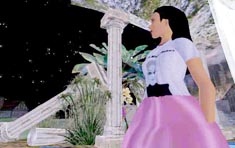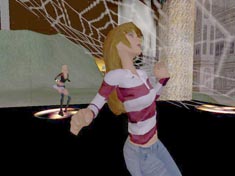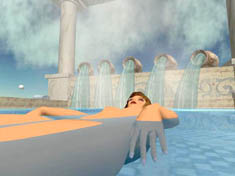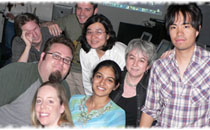|
|

| THE DECISION |
June 2006 marked the
milestone of my first class in the Arts & Technology (ATEC)
masters' degree program at the University of Texas in Dallas (UTD). What led me
to this particular program was the department's reputation for being on the bleeding
edge: it is one of the only universities in this country with a working motion
capture lab. That makes it a huge magnet for animation and game designers-in-training.
Its dean, Thomas Linehan, enjoys some renown for having started and established
this same masters program at one of the leading American design schools, the Ringling
School. There's a new branch of the degree plan that is offering classes in Emerging
Media like video and sound for the web. And, there's even some sound and music
design within the degree's scope. Very few schools anywhere offer such an expansive
degree at a masters level, which makes it versatile, and in my case a good fit
for my mix of skills in art, music and technology. There's a breathless excitement,
being on the bleeding edge, where art and technology are morphing minute-by-minute
into new forms of expression and communication. The decision to make such a huge commitment of time and money to getting a degree that I will never need as a professional designer/illustrator was not an easy decision. If I hadn't fallen in love with teaching, I would never have considered it. Nor would I have considered getting another degree if the national accreditation rules that establish qualifications for college and university faculty hadn't changed their requirements right after I started teaching. But there was nothing I could do to get around these new rules: it was either get a degree or never teach at a college again. Finally, reluctantly, I made the commitment and took the first step by submitting my application along with the required essay. |
| { read my Masters application essay } |
| CAMPUS ON THE TEXAS PRAIRIE |
Texas has its own aesthetic, but you
have to be the sort of person who likes deserts to appreciate that aesthetic.
And that wouldn't be me. I've gotta have trees, and in the suburbs of Dallas,
there aren't many of them. That's because it all used to be prairies, not so long
ago. Heading out to the 'burbs from the inner city where I live feels like going
to another planet. The trek between home and grad school is about a 30-minute
drive north to the edge of Richardson, a typically homogenized, franchise-populated
suburb. The University of Texas at Dallas is a light-blasted, sun-stroked expanse
of flat, mowed Texas pasture. No interesting features at all. A few modern, low
buildings are scattered here and there, and a scarcity of trees, giving it an
anonymous character. The Arts & Technology building is an innocuous place,
another one of the flat, featureless campus structures. Its only distinguishing
architectural element is its placement at the very foot of a giant radio antennae
tower, its base literally touching the building. It's an easy way to find the
Arts & Technology (ATEC) building: just follow the tower. |
| GRAD SCHOOL, DAY ONE |
My first class, the first day, as I was
getting out of my car right outside the building, I heard someone singing opera.
The acoustic was odd, rather ethereal. It wasn't obvious where it might be coming
from. Then I noticed a guy halfway up the immense radio tower: he was singing
opera in full volume, full voice from high, high up in the air. I took this as
a symbol on my first day of grad school. A symbol of what? That's open to interpretation.
The opera singer seemed ecstatic, expressive and extremely uplifted (literally).
It was also unexpected and serendipitous: an indication, perhaps, of a possible
direction for my graduate school career? The next symbol was on the ground, a few feet away: a little brown bunny rabbit, calmly munching on the grass with a friend, another bunny. An opera singer on a radio tower and bunny rabbits in a field right in the middle of campus? I'm not sure what suggestion the Divine Forces were trying to deliver, but it certainly seemed like an evocative contrast to the ordinary reality on UTD's campus on the prairie. Going into class, I was relieved that it was a Mac Lab, a lab full of G5's. Of course, I had my laptop with me and had already configured it so that I could sign onto the campus wireless network. There were almost 30 people in this class, and I was pretty sure I was the oldest one there. This was something I had dreaded. I just didn't want to deal with the impression my age and gender would stereotypically induce, of a mother whose children have grown up, so she's trying to find herself by going back to college. That's so not me, and I didn't want to be mistaken as such. Otherwise, the group was an inviting one, as it was so culturally mixed, and a good gender balance too. In a computer-centric program like this one, there is a tendency for males to be present in greater numbers. The title of this class was compelling: the Aesthetics of Interactivity. The textbook tickled my imagination too, Hamlet On the Holodeck: The Future of Narrative in Cyberspace. The teacher, Dean Terry ("Dean" is his real first name, not a title) is known for his success as an internet entrepreneur. He started an interactive design firm in Los Angeles called PixelWave, which he sold to Atom Films/Shockwave, well known among fans of animation for its innovation and pioneering presence on the web. He is a quick, slight fellow bristling with energy, with a casual but rather impatiently commanding presence. He has the look of mental high speed. We students were asked to go 'round the room introducing ourselves briefly, though we were told that we would be expected to give full scale visual introductions of ourselves and our work during the next class period. I mentioned during my introduction that I had been the illustrator of a controversial book that I would reveal during my formal introduction, next class. Shortly, Dean called for a brief break in proceedings, and the class left the room. I went outside to loiter my break away, and one of my fellow students came up to me with a cajoling smile. He pleaded, "You MUST tell me what book you illustrated that's so controversial, I HAVE to know, I can't wait!" So I told him the title. To my astonishment, he fell onto his knees and bowed his head to the ground with hands raised overhead. I just grinned and bowed back, hoping to convey my gratitude for such a generous and theatrical gesture of respect. This was Eric Baze, my first friend at UTD. Eric turned out to be a centrifugal force of good cheer and communal magnetism. He had a way of pulling people together and lightening up any atmosphere while adding depth to it as well. This class was his final required course to complete his Master of Arts degree. So he really knew the ropes around school, and this proved very helpful. It was also very consoling, in the midst of all those strangers, to find someone who "knew" me and "got" me without all the usual preliminary getting-to-know-you stuff. |
| INTIMIDATION INDOCTRINATION |
My worst dread was fully realized in
this class, where I was the oldest person, old enough to be a parent of most of
the students, some of whom called me "Ma'am." After becoming accustomed
to being a teacher, the controller of a classroom, the goddess (or gremlin) of
grades, I wasn't looking forward to being devolved into the powerless role of
student again. Nor did I relish the uncool status of being the oldest student
in the class... yes, older than the teacher too. Immediately, another dread was
heaped onto this one, but it's one that took me by surprise: I didn't expect that
my experience in a lifetime's profession as a designer could possibly be a problem
for me in the context of this degree program. This unfolded during my introduction,
in which I gave a visual presentation of my work by showing my Art Temple website
as well as some animations and music I'd composed. To my shock, one of the male
students attacked my work, even though this session was meant to be an introduction,
NOT a critique. The affront was startling. The student's tone was accusatory and
unfriendly, and he framed his comments as a criticism of my design skills. The
teacher did not come to my defense nor did anyone else, everybody just left me
hanging on this guy's hook, presumably to take in the show, to see what would
happen. I addressed the student respectfully, despite his rudeness, and directly
responded to his comments, not reflecting his confrontational tone. I'm a collaborator,
not a competitor, not much of an opponent to start a fight with. My calm, direct
rationale gave him nothing exciting to engage with, so he let it drop. The rest
of the class was more receptive, generally more pleasant with me. Maybe it's just
that grad school is rather intimidating, but everyone seemed fairly tense initially,
including the teacher. |
| THE JOY OF CONTROLLED CHAOS |
| Fortunately, the atmosphere
started warming up as we began to realize that this teacher was a rather wonderfully
out-there character. Dean Terry is a man out of his time, in some ways. He seems
to see things in the future tense, in ways the rest of us cannot even imagine.
His focus of the moment, the focus that he brought to this particular class, is
his interest in virtual environments, particularly a virtual environment called
Second Life. This is what
set the tone for this class to become a very entertaining place to be, as I shall
recount. We were each supposed to decide what project we'd like to do for the class, and each class period, we were free to work on these. Some projects were collaborative, so there was a lively air of engagement during the class. Dean Terry called this teaching style "Controlled Chaos." People like me brought their own laptops and set those up in front of the lab computer. We did our projects on our laptops and our lab computer was used to fly around Second Life. This was the tone for an entire six week term. I thought it was wonderfully entertaining to be able to work on my project while listening to the hilarity being generated by all the antics taking place among the students who were exploring Second Life. |
|
For those of you who feel that you are a little "e-tarded,"
this article is for you. It's my hope to help you tighten the gap between your
knowledge of the bleeding edge in Cyberspace and wherever your online frame of
reference is right now. |
| EXPLORING THE NEW METAVERSE |
A virtual environment is sometimes referred
to as a Metaverse. Quoting from Neal Stephenson's compellingly future-forward
book Snow Crash, "The Metaverse
is a fictional structure made out of code. And code is just a form of speech –the
form that computers understand." Not a game, this is a place in Cyberspace
where people can wander, talk, meet each other, do stuff and build things. If
email was 3D, it would be sort of like a virtual environment. It's a communication
space. Also, it's an exploration space for experimenting with the malleable existence
that electrons afford. When you first sign on to a virtual environment like Second
Life, you are given an Avatar, which is just another word for an animated model
that represents you. You can name it and change its appearance, you can walk around,
you can fly, and you can teleport to places within the Metaverse. The day that
our class first signed on to Second Life, there were over 70,000 other people
signed on at the same time! This is surely a new form of community, and one of
our objectives in this class was to explore it. Our teacher said he had bought an island and that we would be having a class there sometime. "Bought?" we asked.... an "island?" Well, a virtual island, of course. Eric chimed in that he had "rented" some land himself, in a place called Discordia, and was "living" in a house that he himself had "built," and did I want to come visit him there? So he told me the steps to take to teleport to his rental property. There was a big building, rather elegant, with only one sofa. He said he was acquiring other furniture soon, hopefully. As it turns out, there is an entire economy on Second Life, and people are actually making money there by creating things that people want to buy. That's right: you can make real money in a virtual world. The currency exchange is 250 Second Life dollars to $1 US, and the Second Life website claims that their marketplace currently "supports millions of U.S. dollars in monthly transactions." One of the most popular means of making money is to create enhancements and pastimes for the Avatars ("create" = 3D modeling and coding). That makes it a lucrative market for designers and programmers. Second Life is a place where you can even buy hair and lips! You can buy other body parts too. And, of course, you can buy clothing, tattoos, shoes. To quote from Dean Terry's blog, "Unfortunately most of the ideas in virtual worlds are shovelware – ideas shoveled from the real world into virtual space. Some have argued this is just what we should do – create virtual versions of real world people, events, and transactions. Certainly there is a role for this, but I'm more interested in the imaginative possibilities of these spaces." Shopping is shovelware, as far as I'm concerned – I don't even like to shop in the REAL world, so I wasn't too interested in shopping in this virtual world either– but out of curiosity I wandered into a few virtual shops to see what could be bought. Probably the strangest thing I saw for sale were wounds! Weapons are sold there too, but Second Life isn't a place where there's shooting; you can get banned from the system if you try to disrupt it. Supposedly, there's a lot of gambling on Second Life, and lots of hanging out in clubs. You can dance at these clubs, using bits of code that are accessed in your "inventory," and that's one of the things I enjoyed doing. While exploring Second Life, you can take snapshots of "yourself," and I am including a few here that I have taken of my Avatar, Dia Goodnight. I haven't personally witnessed any of the "mature"-rated entertainments in Second Life. It's a huge virtual landscape with a lot of fascinating 3D model features like buildings in the sky and coastlines with animated waves. Lots of the virtual spaces are for relaxation and look very cozy. I have, for instance, seen people drinking in Second Life. One of my classmates, an upper level grad student, was fond of having her Avatar walk around with a MaiTai in hand, complete with a little umbrella. About every two minutes, her Avatar would fall down in a virtual drunken heap. There are hazards in Second Life, for sure. Our teacher said, to my astonishment, that you could get pregnant in Second Life. And, he said forebodingly, there seems to be a great deal of slavery in Second Life! One of the curiosities is that you tend to see little orbs here and there. These orbs, if activated, make your Avatar "do" things... like sit down, lie down, meditate, kiss, cuddle, and I'll leave it to your imagination's limits to guess what else. Dean Terry believes with conviction that virtual environments are going to become as common to us as email. He said, "Today's younger generation is going to start forcing the rest of us to start meeting in virtual environments, the same way that our generation forced our parents' generation into using email." There is already some evidence that he is right about this (read more in the cover story on Second Life in the May 1, 2006 edition of Business Week magazine). One of Dean's most intriguing pronouncements was that he was attempting to start a religion in Second Life. It wouldn't be a conventional religion, he said; it would be a religion that addressed the needs of people in a virtual world. He isn't sure what that might consist of yet, but he is exploring the subject. I expressed an interest in attending a sermon, if he ever got one together. Someone suggested that he could require the class to attend his services. He insisted it was only conceptual at this point, and that he had nothing yet to sermonize about. |
| MY FIRST GRAD CLASS PROJECT |
My project in this class was conceptualizing and producing
the basic design for my blog, "View From A Canary Perch." Dean Terry
is a believer in the power of a blog to help a person develop what he calls "an
authentic voice." One of the students, for instance, is an artist who started
a blog on the topic of her struggle with weight and the "expectations placed
on women in contemporary society." Christi Nielsen's blog I'm
Just About To Get Skinny became quite popular over the course of one year,
and she now has an impressive following. She had, in the beginning, been very
shy, but the blog had supposedly helped her emerge from what she referred to as
"an empty shell." And, like Dean Terry, she was spending a lot of time
in Second Life. As a reflection of her identity as a woman struggling with her
weight, Christi had designed an Avatar that was pudgy, whose clothes were too
tight. And sometimes she even attached a ball and chain to the Avatar's ankle
–except it wasn't a ball, it was a bathroom scale. |
| THE CLASS GRANDE FINALE |
The grande finale of the presentations
happened in Second Life, one by Lucas Johnson and the other by Dean Terry. Lucas
staged a performance in which his avatar played steel drums. There was an ensemble
of these steel drums that were coded so that other avatars could play them too.
So what happened was that a good number of avatars showed up in Second Life for
this performance, some playing drums, others dancing. I should add that there
were a few bizarre occurrences at this virtual event, in one case an avatar who
turned himself into Mr. Kool Aid. There was another avatar who was doing something
unconventional with a donkey, and when Mr. Kool Aid saw this, he started doing
the same thing... to another donkey. It should be said that some objections were
raised by classmates during this, shall we say, spontaneous sideline event during
the main performance. The ultimate grande finale was, of course, Dean Terry's first appearance in his role as the figurehead of an as-yet unnamed new religion, and the entire class's attendance at this momentous occasion. For this special event, a virtual amphitheater had been created, the entirety of which floated out over the crashing waves of a virtual coastline, suspended entirely in the air. Features of the open air amphitheater consisted of a podium/altar and floating seats for the audience. The entire class of avatars arranged themselves in these seats, along with a few guests who were not present in real life in our classroom. Among these luminaries, there were a couple of avatars wearing luminescent wings, and one avatar who had flames where his hands should've been. When we were all virtually seated, Dean Terry's beautifully styled avatar Blake Wake took the stage. Many of the audience members were wearing virtual t-shirts that said "Who Is Blake Wake?" In the end, no sermon was delivered, but there was a magnificent performance climax in which Blake Wake blasted off into space like a rocket ship. Eric whispered to me, "I wish we had some music for this, something like The Age of Aquarius." I said, "Hey, I have that on my iPod! So I patched it into the main speakers within moments, and we had a flamboyantly good-spirited soundtrack, truly a song of hope in the future, to accompany this marvelously bizarre virtual performance that the entire class was attending in two forms that day: real world, and virtual world. Both of which are so endearingly strange. |
Summer 2006 |
| next > Little Oz on the Prairie |
 |
ATEC Tower |
 |
My avatar, among ruins in Second Life |
 |
Levitating in meditation in a temple
of colors |
 |
Dancing under a spiderweb in a nightclub |
 |
Floating in a Romanesque pool |
 |
 |
 |
 |
 |
With Dean Terry (back row, far left)
and classmates in Aesthetics of Interactivity |